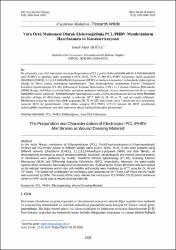| dc.contributor.author | İşoğlu, İsmail Alper | |
| dc.date.accessioned | 2023-11-22T13:21:29Z | |
| dc.date.available | 2023-11-22T13:21:29Z | |
| dc.date.issued | 2019 | en_US |
| dc.identifier.issn | 2147-3129 | |
| dc.identifier.issn | 2147-3188 | |
| dc.identifier.uri | https://doi.org/10.17798/bitlisfen.530767 | |
| dc.identifier.uri | https://hdl.handle.net/20.500.12573/1842 | |
| dc.description.abstract | Bu çalışmada, yara örtü malzemesi olarak polikaprolakton (PCL), poli(3-hidroksibütirik asit-ko-3-hidroksivalerikasit) (PHBV) ve ağırlıkça farklı oranlarda (100:0, 50:50, 75:25, 0:100) PCL/PHBV karışımları, farklı çözücüler(kloroform (CHCl3), 1,1,1,3,3,3-Hexfluoro-2-propanol (HFIP) ve bunların karışımları) kullanılarak elektroeğirmetekniği ile fibroz yapıda membranlar hazırlanmıştır. Tüm elektroeğrilmiş membranlar Fourier DönüşümlüKızılötesi Spektroskopisi (FT-IR), Diferansiyel Taramalı Kalorimetre (DSC) ve Taramalı Elektron Mikroskobu(SEM) ile yapı, morfoloji ve ısıl özellikleri açısından karakterize edilmiştir. Ayrıca, absorbsiyon testi ile sıvı tutmakapasiteleri analiz edilmiştir. Karakterizasyon basamağından sonra, seçilen membranların üzerine insan fibroblasthücreleri ekilmiş, in vitro hücre canlılık ve toksisite, MTT testi ile 24, 48 ve 72. saat için analiz edilmiştir.Membranların üzerine ekilen hücrelerin çoğalması 36, 72 ve 120. saat olmak üzere 3 farklı süre için incelenmiş,sonuçlar SEM ile gösterilmiştir. Elde edilen sonuçlar PCL/PHBV (75:25) karışım ile HFIP çözeltisindeelektroeğrilen membranın yara örtü malzemesi olarak kullanılabileceğini göstermiştir. | en_US |
| dc.description.abstract | In this study, fibrous membranes of Polycaprolactone (PCL), Poly(3-hydroxybutyrate-co-3-hydroxyvalerate) (PHBV) and PCL/PHBV blends in different weight ratios (100:0, 50:50, 75:25, 0:100) were prepared using different solvents (chloroform (CHCl3), 1,1,1,3,3,3-Hexafluoro-2-propanol (HFIP) and their blends) via electrospinning technique as wound dressing materials. Structural, morphological, and thermal characterizations of membranes were performed by Fourier Transform Infrared Spectroscopy (FT-IR), Scanning Electron Microscopy (SEM) and Differential Scanning Calorimetry (DSC), respectively. Moreover, the water-uptake capacity of the membranes were analyzed using absorption test. Following that, human fibroblast cells were seeded on the selected membranes and in vitro cell viability and toxicity were monitored by MTT assay for 24, 48 and 72th hours. The seeded cell proliferation on membranes was conducted for 36, 72 and 120th hours and the results were examined by SEM. The results of this study relieved that electrospun PCL/PHBV (75:25) blend membrane solved in HFIP can be used as wound dressing materials. | en_US |
| dc.language.iso | tur | en_US |
| dc.publisher | Bitlis Eren Üniversitesi | en_US |
| dc.relation.isversionof | 10.17798/bitlisfen.530767 | en_US |
| dc.rights | info:eu-repo/semantics/openAccess | en_US |
| dc.subject | PCL | en_US |
| dc.subject | PHBV | en_US |
| dc.subject | Elektroeğirme | en_US |
| dc.subject | Yara Örtü Malzemesi | en_US |
| dc.subject | Electrospinning | en_US |
| dc.subject | Wound Dressing Material | en_US |
| dc.title | Yara Örtü Malzemesi Olarak Elektroeğrilmiş PCL/PHBV Membranların Hazırlanması ve Karakterizasyonu | en_US |
| dc.title.alternative | The Preparation and Characterization of Electrospun PCL/PHBV Membranes as Wound Dressing Material | en_US |
| dc.type | article | en_US |
| dc.contributor.department | AGÜ, Yaşam ve Doğa Bilimleri Fakültesi, Biyomühendislik Bölümü | en_US |
| dc.contributor.authorID | 0000-0001-6428-4207 | en_US |
| dc.contributor.institutionauthor | İşoğlu, İsmail Alper | |
| dc.identifier.volume | 8 | en_US |
| dc.identifier.issue | 3 | en_US |
| dc.identifier.startpage | 1029 | en_US |
| dc.identifier.endpage | 1044 | en_US |
| dc.relation.journal | Bitlis Eren Üniversitesi Fen Bilimleri Dergisi: Bitlis Eren University Journal of Science | en_US |
| dc.relation.publicationcategory | Makale - Ulusal Hakemli Dergi - Kurum Öğretim Elemanı | en_US |


















